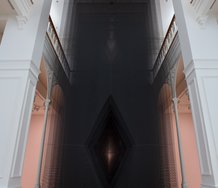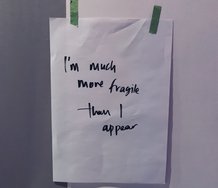Terrence Handscomb – 23 September, 2024
In cultural milieux like AAG and the Walters Prize, the inclusion of identity narratives in explaining what an artist's work means and how it should be critically treated, undoubtedly affords the artists great protective armour from critical interrogation…..When artists talk about what their work means, what it addresses and what it states, and those stories are closely bound up with identity narratives, then their stories quickly lose their exegetic role to become morally enforceable political add-ons.
EyeContact Essay #54
In Aotearoa New Zealand, non-Pākehā art continues to rise in stature, visibility and acceptance. This is particularly evident in the Walters Prize, which has a proud history of prize winners who identify as non-Pākehā, and in particular, those artists whom identify as Māori.
Yet, only a particular type of art is nominated for the Walters Prize. This is art that visually aligns with established art vocabularies and materialities. It is also art that fits nicely with AAG’s institutional willingness to hear non-Pakeha voices and listen to their stories. As a Walters Prize nomination, Māori artist Ana Iti’s installation, A resilient heart like the manawa (2024, kauri timber, steel, rust, audio field recordings) conforms exactly to these principles.
Hers is a visual story told in kauri, steel and sprinklings of rust that tells, with sorrow, of something much loved but now defiled - ka waiata e ia … he tangi mo tōna taiwhenua. This is a story of the Hokianga, the tribal area of Iti’s ancestors. Hers is an elegy of the rape and destruction of historical tribal lands following the arrival of Pākehā to the area in the early 19th century.
A resilient heart like the manawa forms a sparse replica of the wharf at Rāwene, a historical and functional landmark which sits opposite the tribal lands of Iti’s hapu, Ngāi Tūpoto. At first, the mood that Iti brings to this work appears to be one of quiet elegiac loss and determined resistance, as its title implies. But on another level of interrogation, and given the art political milieu of the Walters Prize, the story reads as a tacit reproval of white privilege, material greed, frequent malversation, and a ruthless profit-driven urge to gain material advantage over others.
In the early nineteenth century, Europeans began to establish significant settler communities in the far north, making the Hokianga Harbour and the community of Rāwene (originally named Herd’s Point), a principle Pākehā export hub, with sawmills and boatbuilding yards. By the end of the century, Rāwene ‘had become renowned for increasing settler appetites for the area’s natural resources and accelerating the degradation of its waterways and forest.’ (1)
In a text discussing the woman whose back was a whetstone (2021) - one of the works by Iti nominated for the Walters Prize - the whakapapa of the artist’s work is traced to the atua Hinetūāhōanga. This Māori goddess is seen as an embodiment of the stone-grinding implement tūāhōanga or hōanga, as it is also known. Tūāhōanga is a key component in the making of carving tools used in mahi whakairo, of the making of waka, and of weapons, such as the infamous skull-splitter patu pounamu.
On the other hand, A resilient heart like the manawa, evokes Hinetūāhōanga not only as an atua whose essence is directly embodied in stone - as it is in the Ōamaru stone used in Iti’s earlier work - but the primordial presence of the goddess is also seen ‘as a knowledge-holder for the respectful harvesting and creative transformation of resources and materials from te taiao (the environment).’ (2)
Expanding this theme, the work corresponds to the touch of the tūāhōanga, ‘the shifting points of contact between cultures and environments which generate new meaning.’ Not only does her work touch the shifting points between cultures - ostensibly the shifting points that lie on distinct cultural paths, which vacillate between divergence and convergence - but it also allows meanings to touch the shifting critical perspectives from which opposing histories may be told, and perhaps reconciled. (3)
However it is not always a soft even touch that mollifies cultural frictions. For before the sharp edges of difference can be smoothed down by the presence of the goddess, the unevenness of cultural surfaces might be more easily understood as the progenitor of rhetorical conflicts that are best fought and won in plain sight.
Yet, despite the political acknowledgements and acceptances that currently exist between Māori and Pākehā, cross-cultural conflicts between the two diverse peoples continue. These conflicts are politically exacerbated when indignation, judgement and historical grievances are voiced. When indictments of blame and demands for contrition become mixed up in the telling of histories which are not easily heard, it is usually because those histories point to strategic errors committed on both sides of a cultural divide. This then prompts at least two heresies.
The first states that Te Tiriti o Waitangi has tethered both Māori and Pākehā to 19th century models of capital distribution, in which one social class dominates another, politically, economically, and socially. Except now the distribution of capital follows lines of exchange in which capital finance is global and hegemonic. The neo-liberal project has made certain that capital and its distribution is no longer bound within national borders by traditional legislative entities, like the Crown. Capital is now distributed by transnational puppeteers who serve greater hegemonic wills. They pull strings, accrue capital and manipulate markets from vantages that are invisible to us mere mortals.
The second heresy simply asks the question: to what extent were pre-Treaty Māori complicit in their own colonisation? A resilient heart like the manawa entails both.
I have long held the contention that when a work of art enters the public domain, the semiotics of its meaning are up for grabs.
It is to great effect that the simple materials used in A resilient heart like the manawa and its referential location in Rāwene, engender many stories and entail many histories. Some of these histories are applied to the work as a direct exegesis and speak of the motives behind its making, and of the artist’s feelings and intentions. These sorts of stories can be helpful, useful, insightful, and sincere. They are easily accepted, respected and believed.
But, in cultural milieux like AAG and the Walters Prize, the inclusion of identity narratives in explaining what an artist’s work means and how it should be critically treated, undoubtedly affords the artists great protective armour from critical interrogation. To criticise the formal and semiotic properties of any work that is extrinsically bound up with powerful identity narratives, is tantamount to criticising not only the artist’s identity, but by extension, to criticise all others projecting the same identity. When artists talk about what their work means, what it addresses and what it states, and those stories are closely bound up with identity narratives, then their stories quickly lose their exegetic role to become morally enforceable political add-ons.
The telling of such identity narratives is everywhere in contemporary art. This partly explains why the criticism of art has become so politicised. But such stories always come to a work from the outside and are deemed to be determinate and critically intractable. This is the tyranny of extrinsic narrative, under whose autocracy the art world has become soft.
Welcome to the world of art criticism. Welcome to the elite world of the Walters Prize with its liberal pieties. Welcome to the chuffed-up privilege and artificial hypocrisy of le monde de la haute bourgeoisie that postures as art patronage in this country. But more importantly, welcome to the soft Pākehāising of New Zealand art, because this is exactly what the Walters Prize does best.
❡
Relocating the site-of-reference of the woman whose back was a whetstone from Ngāmotu New Plymouth to Te Tai Tokerau, and then historically locating it in 19th century Rāwene, strategically shifts a story of the presence of the goddess Hinetūāhōanga and the whakapapa of the artist’s process to a political exegesis which emphasises one historical narrative at exactly the same time as it deemphasises another. There are some histories that are best left unheard.
These are the stories, that if told out loud, would tell of just how swiftly pre-Treaty Māori adapted to, then replicated, Pākehās’ preferred mode of material exchange - the capital domination of others.
In A resilient heart like the manawa Ana Iti tells of something once loved but now lost - te whenua o tōna hapu. But on a more nuanced level of semiotic interrogation, the work not only indicts the pre-Treaty greed of Pākehā traders, but it also arraigns the post-Treaty legislative cunningness of settler administrators.
Having secured a legal mandate under the terms of Te Tiriti o Waitangi and international law, post-Treaty Pākehā swiftly enforced legislative control over Māori, profiting from their resources, and striping social independence and self-governance from once-proud iwi and hapu.
Under the colonial administration of George Grey (1812 - 1898), the brutal confiscation and the annexation of traditional Māori lands quickly became despotic - in much the same way as the British Crown was, at the same time, doing in Ireland — although Māori land was bought legitimately, if not unfairly. Occupying vast swathes of land, post-Treaty Pākehā were able to diminish Māori’s growing fiscal acumen and wrest away their ability to generate their own capital wealth needed to maintain their own tribal governance.
In the first half of the 19th century, Sydney-based traders and hungry Christian missionaries living under the protection of Ngā Puhi leader Hōne Heke Pōkai, whom having little food sources of their own, exchanged muskets for Māori-grown produce and materials, principally potatoes and flax. With devastating affect, the introduction of European munitions to Māori - cheaply made muzzle-loading smooth-bore muskets - as points of trade, quickly escalated into an intertribal arms race. With as many as 3,000 battles and raids, warring tribes were able to exact revenge for past wrongs, avenge old defeats and gain new territory.
With a musket in hand and a heightened sense of invincibility, a Māori warrior could, at a distance of ten metres, take out an adversary coming at him with a stone-age weapon. For Māori, this brought about an existential crisis in which, over a span of thirty years, Māori military technology evolved from stone age to iron age.
But to fold the metonymy of iron and fire into a reading of A resilient heart like the manawa is to force two diverse mythologies to occupy the same semiotic current. This then extends Iti’s story of Hinetūāhōanga and a wistful return to the time before Pākehā, into a Promethean allegory of fire and steel.
This allegory tells of how the European colonisation of Māori was seeded the moment the goddess Hinetūāhōanga fell back upon the earth, “reclin’d … on death’s bloody bed … Oh peace, soft peace, art thou forever gone, Is thy fair form indeed for ever flown?” … and how the Promethean error that brought fire down to earth brought also a new kind of devastation upon Māori. Against forge and fire, the steady grind of the tōāhōanga is lost, as Iti’s Walters Prize nomination comes to symbolise even greater loss to Māori. The incendiary force of fire and steel, of gunpowder and lead, would burn hot and burn long. (4)
Between 1806 and 1845 an estimated 20,000 - 40,000 Māori perished in war. Tens of thousands more were enslaved, treated as taurekareka (the lowest of the low) and driven from their tribal lands to work in the potato and flax fields of their conquerors; mainly a coalition of northern iwi and hapu lead by the powerful charismatic warlord Hōne Heke. As a result of war, long established tribal boundaries were significantly and permanently altered.
Following the devastation, and with thin promises of fair governance and social order, many Māori rangatira unwittingly signed over their tribal independence to the national governance models of the British Crown. Following the signing of Te Tiriti o Waitangi, Māori hapu and iwi were quickly subsumed under the unfamiliar power of parliamentary legislation with its rule of law enforced by powerful constabularies. Māori pushback was inevitable.
Yet, pre-Treaty Māori were extremely accomplished agrarians. This was reflected in how swiftly the agricultural practices of Northern Māori were adjusted to the Pākehā principles of capital exchange. Māori replicated in very effective ways the primitive capitalist relationship between production, profit and expense. In much the same manner as production levels and profit margins in the Americas had relied on slave labour before and after thirteen of the original British colonies seceded from Crown rule, Māori were able to achieve advanced levels of productive output and profits, based largely on slave labour.
In other words, the Pākehā ‘pursuit and exploitation of natural resources’ dove-tailed nicely with tribal appetites for power. Albeit on the backs of slaves and under the conditions of war, for a short time at least - just under forty years - pre-Treaty Māori of the far North were able to enjoy advanced material prosperity, power and mana.
Sadly, this is no longer the case. Although an upward social and fiscal recalibration of te ao Māori is extant, the slim materiality of Iti’s work and its lament, symbolically lays all blame at the feet of Pākehā as it underlines the continued fiscal divide between Māori and Pākehā.
❡
The strong Pākehāising of New Zealand art is identical to its softer articulations, but with added layers of critical interrogation that impeaches the unimpeachable, as it cuts down the hegemony of liberal piety. In the current cultural climate, such art criticism is easily deemed to be angry, resentful, ignorant and culturally insensitive. Any insensitive criticism of contemporary non-Pākehā art also runs the risk of appearing to be anachronistic and well past its best-before-date.
But to tackle Ana Iti’s work by interrogating her stories with words that push well beyond the limits of respectful deference to her identity, is to enter the battlefield of language where cognitive and emotional empathy is overridden by words and the voicing of that which may be best left unsaid. When the double-edged sword of critical judgement swings both ways across any cultural divide, no one gets away uncut.
If the heroic imagery and attribution errors that we all weave into our own identity stories are severed from the heart, and a ruthless critical logic strips an artist’s work of all extrinsic baggage, then so are jettisoned the sort of stories that tell us that the victories of our enemies are unfair because our own defeats are unjust.
Māori artists will make art, as Ana Iti is wont to do, that speaks of cultural reclamation, of the reseeding of dignity and the rising up of good. They may also speak of kotahitanga, of Māori solidarity and call for cross-cultural unity.
But, in the end when we all shut up and the talking heads are silenced, the only thing left talking will be the art. Yet, this may never seem to be quite enough, because when art does get to speak for itself - despite the pompousness of the institutions, the cowardice of the academy, the racket of the marketplace, and the squabbles for power and artist recognition - the only thing heard will be a whisper in the ear of the beholder.
But herein lies the sweetest of ironies. Little else is needed.
Terrence Handcomb
(1) The Walters Prize 2024, AAG installation wall text for A resilient heart like the manawa.
(2) From a text developed for the exhibition Te Hau Whakatonu: A Series of Never-ending Beginnings curated by Taarati Taiaroa, 5 August 2023 - 11 February 2024, Govett-Brewster art Gallery.
(3) Ibid. AAG installation wall text.
(4) Percy Bysshe Shelley. Obscure fragment published in 1810 in the volume Posthumous Fragments of Margaret Nicholson under the heading “Ambition, power, and averice, now have hurl’d,” (lines 21, 63, 64 respectively). Also in The Complete Poetry of Percy Bysshe Shelley, Vol 1, eds. Donald H. Reiman and Neil Fraistat (Baltimore & London: John Hopkins University Press, 2000, pp. 93, 94).



 Advertising in this column
Advertising in this column Two Rooms presents a program of residencies and projects
Two Rooms presents a program of residencies and projects



This Discussion has 0 comments.
Comment
Participate
Register to Participate.
Sign in
Sign in to an existing account.